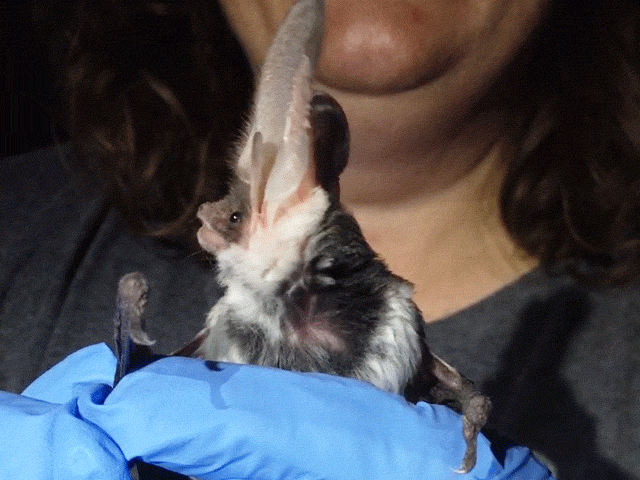
NPS photo 
NPS photo Bats: Heroes of the Night Sky and the Sonoran DesertAlthough Organ Pipe Cactus has its share of insect-eating bats, it is the nectar-eating bats that are the true heroes of the night sky and the Sonoran Desert. They are the primary night pollinators of the saguaro and organ pipe cactus, which makes them indispensable to the Sonoran Desert ecosystem. Every year as the cactus buds begin to form, thousands of lesser long-nosed bats (Leptonycteris yerbabuenae) migrate north from their winter homes in central Mexico. They follow the blooming season of many types of columnar cacti. This “nectar trail” eventually brings the bats here, just as the saguaro and organ pipe are about to bloom. Blossom and bat are uniquely adapted for each other: the flower provides food in the form of nectar and the bats consume it. In the process, they pollinate the flowers. Saguaros and Lesser Long-nosed BatsWhen the night-blooming saguaro and organ pipe flowers first open, they emit a sweet, musky perfume. The bats seek out the source of this highly attractive odor. They poke their long noses deep into the tubular cactus flower reaching for the sweet nectar. Their long tongues lick up the syrup. When the bats emerge from the flowers, their heads are covered with pollen. As these feeding bats fly from flower to flower, they also pollinate the flowers. After the bats have their fill, they often seek a night roost, where they can rest, digest their meal and groom themselves. Throughout the night, the bats will leave roosting spots to feed again and again, often returning to the colony to check up on their young called pups. These colonies will usually use abandoned mine tunnels or caves as day roosts, safe places to rest, rear young and wait until nightfall. Not just any cave or tunnel will do. Bats are sensitive creatures. Each roost must have the proper range of temperatures and humidities. Only a few such places exist, and the bats return to them year after year. These locations are not just bedrooms; they are maternity wards. The bats gather by the thousands in these locations, and each female gives birth to just one pup. Research shows that lesser long-nosed bats are not as sensitive as some other bat species, but their roosts do offer a fairly constant environment and a degree of protection from predators, like owls or bobcats. As the summer season progresses, organ pipe and saguaro blossoms set fruit. The bats now become fruit-eaters. Once again they feast at the cactus buffet. They are not alone. Many mammals, birds and insects all feast on the sweet fruit. The juicy pulp is highly digestible; the seeds are not. As they defecate, all of these creatures deposit seeds, thus spreading the potential for more cactus plants to germinate. In late summer, as the fruit supply diminishes, adults and young bats begin the return trip to Mexico, sometimes first heading to the high country of southeast Arizona to feed on agave blooms. Once those blooms have withered, the bats return to Mexico where once again they will renew their annual cycle of migration. Learn More About BatsIf you would like to learn more about bats, check out Bats Conservation International.More About Bats in ArizonaShowing results 1-8 of 8
|
Last updated: July 18, 2023








